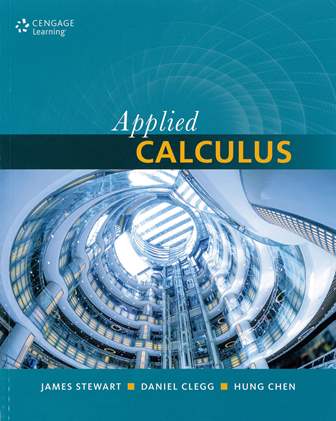Applied Calculus
售價
$
1,150
- 一般書籍
- ISBN:9789865632090
- 作者:James Stewart, Daniel Clegg, Hung Chen
- 版次:1
- 年份:2015
- 出版商:Cengage Learning
- 頁數/規格:672頁/平裝彩色
書籍介紹
本書特色
目錄
Description
Applied Calculus is designed as an introduction to calculus for students in business, economics, and the social sciences. To address the trend of information-based economy and decision making, representation of table-property data in functional form is addressed. We take an informal, intuitive approach to the subject, without sacrificing mathematical integrity. And we aim to balance conceptual understanding with technical skills.
There is a wide range of students’ abilities in the applied calculus course and we have taken steps to address this phenomenon: On the one hand, we know that there are many students with weak algebraic skills and so we provide careful, patient explanations in the exposition and plenty of algebraic steps in the solutions of the examples. And before some of the exercise sets we include warm-up problems called “Prepare Yourself” to practice the skills needed for the exercises that follow. On the other hand, in such a course there are usually some students who are quite mathematically talented and accordingly, not wanting to neglect them, we have placed a collection of problems labeled “Challenge Yourself” at the end of most exercise sets.
Applied Calculus is designed as an introduction to calculus for students in business, economics, and the social sciences. To address the trend of information-based economy and decision making, representation of table-property data in functional form is addressed. We take an informal, intuitive approach to the subject, without sacrificing mathematical integrity. And we aim to balance conceptual understanding with technical skills.
There is a wide range of students’ abilities in the applied calculus course and we have taken steps to address this phenomenon: On the one hand, we know that there are many students with weak algebraic skills and so we provide careful, patient explanations in the exposition and plenty of algebraic steps in the solutions of the examples. And before some of the exercise sets we include warm-up problems called “Prepare Yourself” to practice the skills needed for the exercises that follow. On the other hand, in such a course there are usually some students who are quite mathematically talented and accordingly, not wanting to neglect them, we have placed a collection of problems labeled “Challenge Yourself” at the end of most exercise sets.
Features
- The writing style speaks clearly and directly to students, guiding them through key ideas, theorems, and problem-solving steps, and encouraging them to think as they read and learn calculus.
- Prepare Yourself exercises are designed to check students' prerequisite skills before they attempt the core exercise set. These exercises acknowledge the variety of math abilities, and show students what they need to work on before they move forward.
- Challenge Yourself exercises are more difficult problems intended to elicit students' deeper understanding of key concepts. These exercises are designed to be assigned by instructors who wish to aim at a higher level and keep their more advanced students interested.
- Projects are included throughout to motivate students and help them see the relation of calculus to real life and their intended fields of study. They can be worked in class, assigned as group projects, or given as extra credit.
- At the beginning of each chapter review section is what we call Concept Check, which is a collection of questions designed to make sure that students know the main concepts of the chapter. The answers to these Concept Check questions are all collected on the back endpapers, thus constituting a review of the entire course.
Table of Contents
0 Precalculus Review
1 Functions and Models
2 The Derivative
3 Techniques of Differentiation
4 Applications of Differentiation
5 Integrals
6 Applications of Integration
7 Functions of Several Variables
8 Trigonometric model
9 Power Series Approximation and Taylor Series
Answers to Odd-Numbered Exercises
Index
0 Precalculus Review
1 Functions and Models
2 The Derivative
3 Techniques of Differentiation
4 Applications of Differentiation
5 Integrals
6 Applications of Integration
7 Functions of Several Variables
8 Trigonometric model
9 Power Series Approximation and Taylor Series
Answers to Odd-Numbered Exercises
Index

